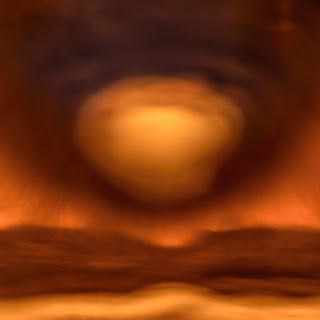"We are surrounded and embraced by her;
powerless to separate ourselves from her,
and powerless to penetrate beyond her.
We live in her midst and know her not.
She is incessantly speaking to us,
but betrays not her secret.
As I - finally! - jump back into the practice of posting an image or two with accompanying quotes (I've been busy with "day job" activities and travel for what seems like forever! - for those kind readers who are still with me, a humble bow and "Thank you!" for your patience), there is no better place to start than by explaining what the title of this blog entry ("Oysters, Beyuls, and Palimpsests") is referring to.
I have written before of viewing old subjects with new eyes (that summarizes how a Kauai I thought I knew well after multiple visits that began in the early 1980s, gradually revealed new truths about herself, but only after I changed my own way of "looking"), but never before have I experienced this as deeply as I did on the most recent trip my family and I took to the Pacific Northwest; specifically, the eastern part of the Olympic Peninsula that opens into the Hood Canal. As on myriad past trips, my reading material played an unexpected but vital part in steering my eye/I toward specific elements of the physical environment. In Scotland, I was "accompanied" by a biographies of William James (in 2009) and of Jon Schueler (2016), and both shaped the photography I did on those trips; likewise, in Kauai (in 2014), my compositions arose in part from a book about the island's history that I was immersed in on that trip; and the same in Alaska (in 2018), when a book on Alaska's history gently fueled my imagery. On our first trip to the Northwest (in 2019), I was reading histories and biographies of 19th century Western/U.S. photographers (William Henry Jackson and Carleton Watkins), and my photographs from that trip tended toward the Ansel-Adams-ish "epic" macro landscapes. But, on this most recent trip, my lens was almost always trained on far quieter and subtler kinds of micro-landscapes.
To be sure, part of the reason was the weather. While July's "heat dome" (that descended over much of the Pacific northwest) had dissipated by the time we arrived, it had not gone entirely, and the area was blanketed in unseasonably high temperatures and perfectly clear skies (i.e., far from ideal conditions for landscape photography). Luckily, the book I chose to accompany me on this trip provided both solace (from the physical conditions) and nourishment (of a spiritual kind), that together compelled me to view an old subject with astonishingly new eyes.
The book is called The Heart of the World, one of seven that Ian Baker has written on Himalayan and Tibetan cultural history, environment, art, and medicine. This particular book - written in 2004, and one of the very best adventure/spiritual-quests I have ever read (!) - is ostensibly about finding a fabled colossal waterfall deep within an unexplored part of Tibet’s Tsangpo gorges in the Himalayas (Baker has subsequently been honored by the National Geographic Society as one of six ‘Explorers for the Millennium’ for the ethnographic and geographical research he was a part during his quest to find this waterfall), but is really an extraordinary (and extraordinarily spiritual) account of how one's state-of-mind/reality determines access to Beyul, or "hidden lands where the essence of the Buddhist Tantras is said to be preserved."
Writing of Beyul, the Dalai Lama asserts in the book's introduction, that "...such sacred environments ... are not places to escape the world, but to enter in more deeply. The qualities inherent in such places reveal the interconnectedness of all life and deepen awareness of hidden regions of the mind and spirit. Visiting such places with a good motivation and appropriate merit, the pilgrim can learn to see the world differently from the way it commonly appears..."
While in the Pacific northwest, I read small bits of The Heart of the World each day, cherishing and relishing it's quiet insights and deep wisdom before drifting off to sleep, and anticipating the next day's activities. The result was that my attention was drawn far less to "Wagnerian epic"-like vistas, and more (so much more!) to the timeless essence of place - such as the Oyster-shells seen in the triptych above. Why Oysters? For one thing, our Airnb rental was close to the Hamma Hamma oyster saloon near Lillywaup, WA; so - given the "non photographer's weather" - my wife and I wound up having a lot of time to kill during the day enjoying local quisine. For another - in dreams at least - oysters are associated with quiet meditation and “going within." And, since like palimpsests, oysters record both time and events, their ubiquity in Lillywaup (heck throughout the Hood canal) entwined with my nightly excursions into Tibetan Beyuls. Oysters became my own palimpsests of spiritual and aesthetic journeys, both real and imagined. I was utterly mesmerized by their siren call; the elegance of their form, and the numinous quality of their decaying shells. And on those rare occasions when I was lucky enough to have particularly "good motivation and appropriate merit" - such as when I chanced upon a small deserted beach strewn with oyster shells - the results were pure magic! I caught brief glimpses of the preternatural luminescence that permeates an ineffable Beyul-of-the-mind.
For those of you interested in viewing a few more examples of what I'm tentatively calling "Numinous Palimpsests," I have posted a small portfolio on my main website.




































